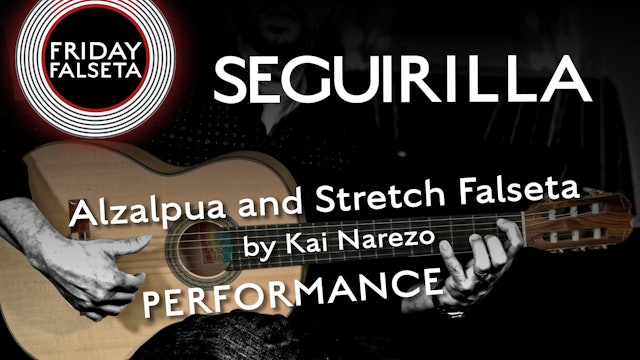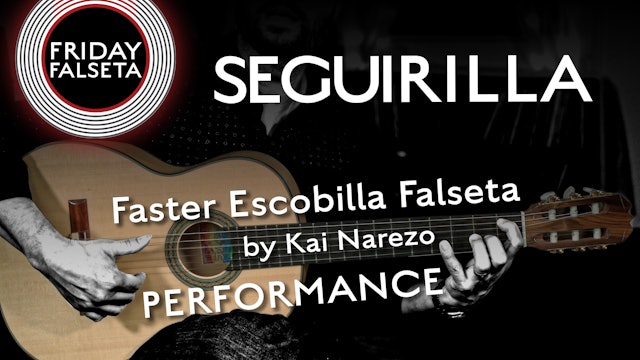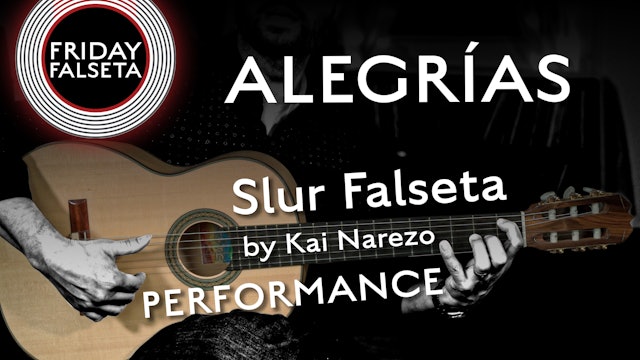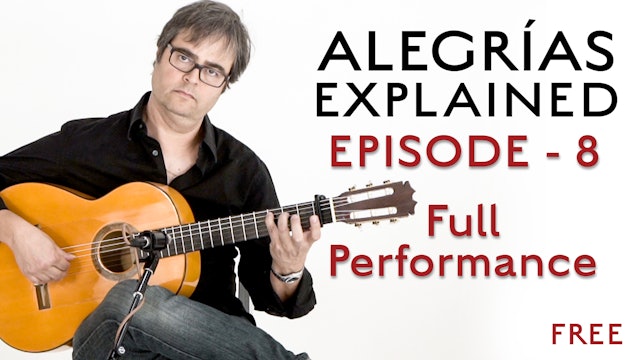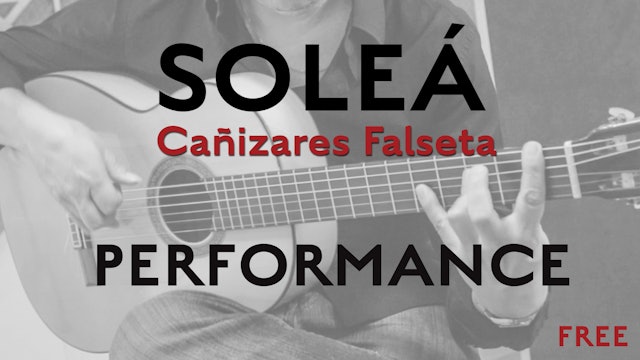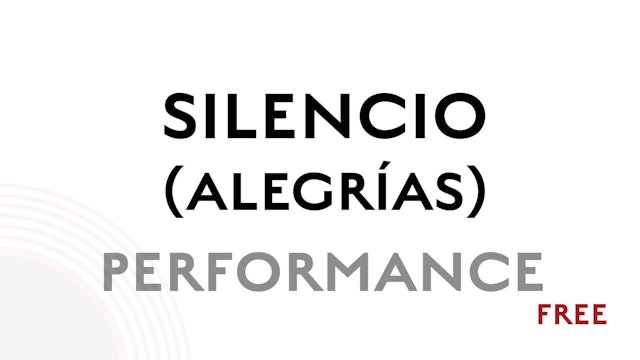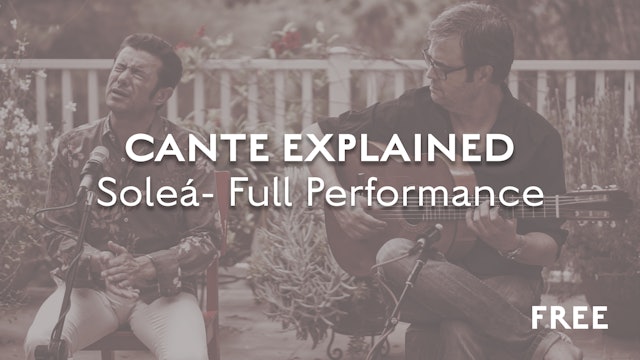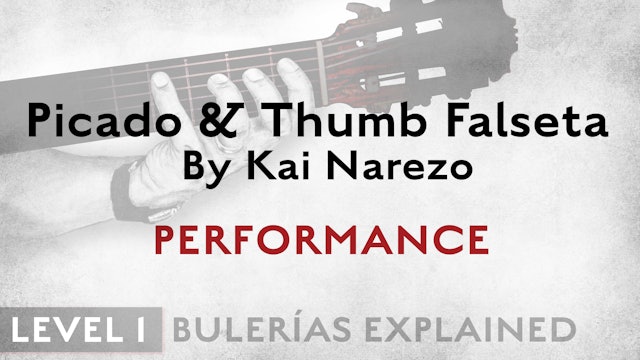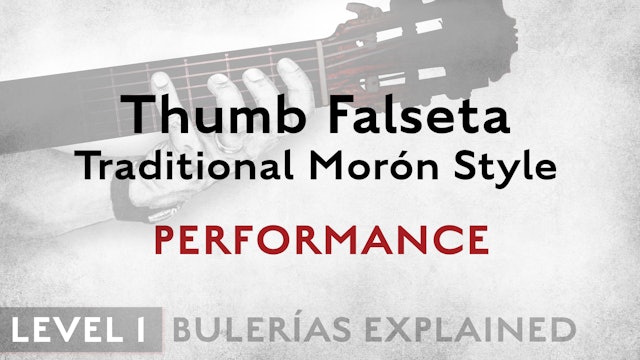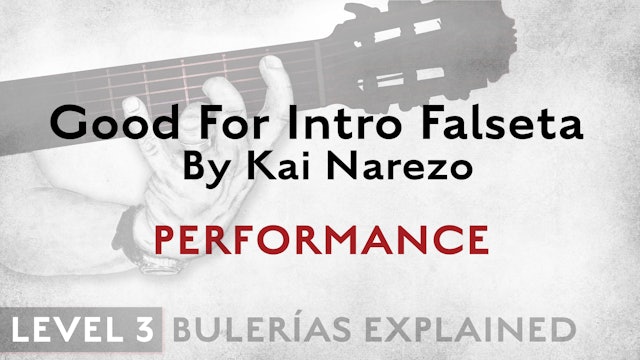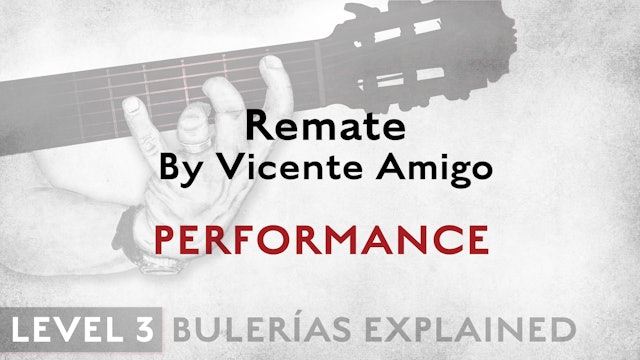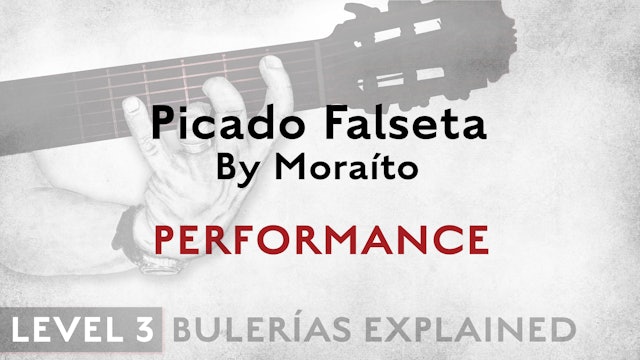-
Friday Falseta - Tangos Traditional Line Cliche by Kai Narezo - PERFORMANCE
A line cliche is when one note within a chord moves by half-steps. The second half of this falseta features a line cliche on the D minor chord where the bass note moves down from the note D on the fifth string. This is a traditional figure that you’ll probably recognize more once you learn to pla...
-
Friday Falseta -Alegrias Escobilla Variation Falseta by Kai Narezo - PERFORMANCE
Here’s a fun fasleta that’s relatively straightforward and will add variety to your Escobilla por Alegrias. The right hand is all P-M-A and the melody is mostly scale wise motion, using an E Major scale in the 6th position. It’s almost all triplets, so once you have the right hand down it’s all a...
-
Friday Falseta - Seguirilla Alzapua & Stretch by Kai Narezo - PERFORMANCE
Here’s an uptempo Seguirillas falseta you might want to practice with a capo, given the left-hand stretches involved. In addition to the stretches it’s a good alzapua workout, so make sure you’re relaxed as you learn and practice this one. And try to hear the sextuplets in the alzapua before you ...
-
Friday Falseta - Bulerias Falseta Por Fiesta by Kai Narezo - PERFORMANCE
I say this one is good Por Fiesta because it’s all thumb so you can play it loud and, once learned, should be playable at quick speeds. Watch out for those pickup notes at the beginning, though, as it starts just after beat 10.
-
Friday Falseta - Tangos Alzapua Workout #2 by Kai Narezo - PERFORMANCE
This Tangos falseta features a very common alzapua burst and quite a bit of left-hand / right-hand coordination to make it sound its best. Also, watch out for the rhythm change from 16th to 8th notes.
-
Friday Falseta - Seguirilla Faster Escobilla Falseta by Kai Narezo - PERFORMANCE
This Seguirilla falseta works best at faster speeds, making it useful for Escobillas or any other time you need a fast-tempo falseta. You’ll want to watch out for the compás, and also for the left hand, which needs to leave space for adjacent open strings to ring. As always, simple doesn’t mean e...
-
Friday Falseta - Alegrias Slur Falseta by Kai Narezo - PERFORMANCE
Here’s a short but tricky Alegrias falseta that will really work both your left hand and your compás. In addition to some 16th note slurs that include a lot of pinky action, the phrases don’t quite resolve where we would expect them to. Once you’ve learned the notes, make sure you’re really comfo...
-
Alegrias Explained - Episode 8 - Final Performance
This is the final performance from our Alegrías Explained episodes. See how it all comes together with the Cante, Baile and Guitar from top to bottom! To understand and hear all the explanations between the three: Cante, Baile and Guitar, in large detail of each section, there are 7 lesson episod...
-
Friday Falseta - Cañizares Solea Falseta - Performance
Friday Falseta - Cañizares Solea Falseta - Performance
-
Friday Falseta - Tomatito Tanguillo Falseta - Performance
Friday Falseta - Tomatito Tanguillo Falseta - Performance
-
Seguirillas Explained - Escobilla Falseta - PERFORMANCE
If you're only going to learn one falseta por Seguirillas, learn this one. It's very traditional and it's one you just have to know, even if you don't accompany dance.
-
Buleria 1 Guitar Solo - Performance
Watch this to see what we'll be covering in the Buleria 1 Guitar Solo lesson or to refresh your memory once you've gone through the lesson.
-
Tangos Explained - Guitar Solo - Performance
This short Tangos solo features a lot of compás and three falsetas that cover arpeggio, alzapua and picado techniques. You can learn it as played or you can think of it as a template for dropping in new falsetas and compás variations as you learn them.
-
Solea Guitar Solo 1 - Performance
Solea is the oldest of the flamenco forms and having a good understanding of Soleá will help you in all aspects of flamenco. Plus, it's traditional for guitarists to start here. This solo covers all of the essential concepts and techniques that we will look at in other videos.
-
Solea Compas Examples - Performance
Watch this to see what we'll be covering in the Solea Compás examples tutorial.
-
Silencio (Alegrias) - Performance
This is a great traditional Silencio - the slow lyrical section of the danced Alegrias. If you don't have a Silencio yet this is a great one to have, and it's a nice picado study, too.
-
Cante Explained - Soleá - Complete Performance
Kai and Juan perform a Soleá that includes a Salida, two letras (each in a different style) and a Macho that speeds up a bit and goes to the parallel Major key.
-
Tientos Explained - Embellishment - Performance
Three ideas for compás embellishment in an advanced form.
-
Tientos Explained - Falseta by Tomatito - Performance
This Tientos falseta by Tomatito use thumb technique and alzapua, and features a couple of big stretches in the left hand.
-
Bulerias Explained - Level 1 - Picado & Thumb Falseta by Kai Narezo - PERFORM
The first Bulerías falseta I ever wrote 🙂 Each phrase is made up of 8th notes that start on 12 and end on 6, so by now it should just be a matter of learning the notes.
-
Bulerias Explained - Level 1 - Thumb Falseta Traditional Morón Style - PERFORM
This is a very traditional falseta in the Morón style (Morón de la Frontera is a town not too far from Sevilla that’s famous for its flamenco). The falseta is relatively simple and involves thumb technique in the right hand and some slurs in the left hand. The phrasing is very traditional and thi...
-
Bulerias Explained - Level 3 - Good For Intro Falseta by Kai Narezo - PERFORM
This Bulerías Falseta combines arpeggio, picado, thumb and some left-hand stretches into a somewhat longer falseta than we’ve seen. It can be used as an introduction but also works anywhere else you’d play a falseta.
-
Bulerias Explained - Level 3 - Remate by Vicente Amigo - PERFORMANCE
While perhaps not technically a falseta (there’s no real definition that I know of, but this feels like a bit less than a falseta), this is a great little bit to throw in between falsetas or after the singer has finished a letra. Check out the way the melody connects to the 10-11-12 phrase that p...
-
Bulerias Explained - Level 3 - Picado Falseta by Moraíto - PERFORMANCE
Not only is this a great-sounding Bulerías falseta, it’s also a fantastic picado burst exercise. It also features some interesting phrasing and syncopation, so stay focused!





